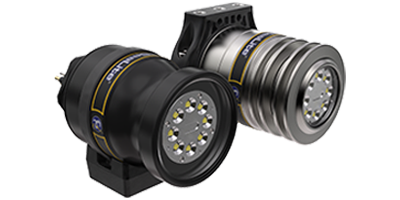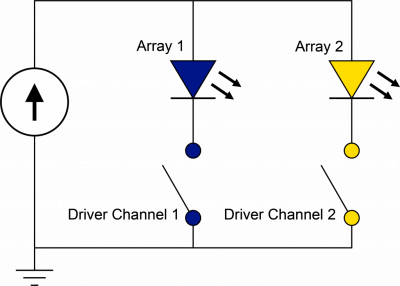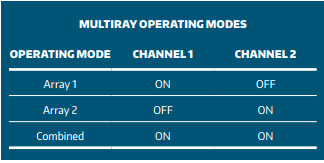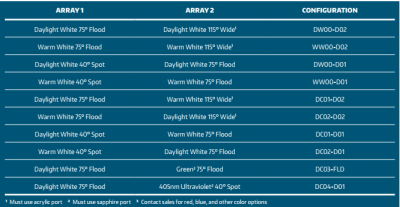Multiray® LED SeaLite®: Do More, See More
As seen in the August 2017 issue of ROV Planet.

The LED SeaLite has many configuration options to address and adapt to market needs.
DeepSea Power & Light (DSPL) released the LED SeaLite in 2016 to provide high configurability and the quality that DSPL is known for at competitive pricing. The LED SeaLite incorporates compact design, high efficiency electronics, and optional SeaSense™ serial command control with a wide range of analog control options.
The LED SeaLite has many configuration combinations. Features include up to 10,000 lumens output in both AC and DC driver configurations; aluminum or titanium housings; a sapphire port with a 6,000 m or 11,000 m depth rating, or an acrylic port with 4,000 m depth rating; and wide, flood, or spot single beam angle configurations. This subsea LED light is field serviceable with no soldered wire connections or specialized tools required. DSPL’s broad connector compatibility coupled with the option to fit a classic mounting collar or compact saddle bracket makes integration simple.
Three LED SeaLite models are currently available: LSL-1000, LSL-2000, and the new Multiray LSL-2025. The Multiray LSL-2025 model introduces compelling technology that configures a single luminaire with two sets of LED sources that can be operated independently or in tandem, each with its own color and beam pattern.

Figure 1. Multiray is available with 8 or 32 LEDs in the light engine. The light engine is divided into two arrays of LEDs each of which occupies half of the available positions in a balanced layout.
Multiray: Designed for Versatility and High Performance
In the LSL-2025, the light engine is divided into two arrays of LEDs. Each array can be populated with a different color of LED source, selected from: whites, blues, greens, reds, and other colors; along with ultraviolet and infrared non-visible emitters. LED arrays can be fit with a choice of optics to produce a variety of beam patterns from a 115° wide flood to a 28° narrow spot. Two different light engine configurations exist: an 8-LED and a 32-LED. In both configurations, each array occupies half of the LED positions within the light engine (Figure 1). These layouts accommodate a wide variety of LED source and optic combinations.
Each array is connected to an output channel on the internal DC-DC constant current driver through a switching circuit expansion board. Intelligent microprocessor control allows the driver to power each array, and in some configurations, both arrays simultaneously. The control design allows the driver to power each array and to manage each channel’s operation (Figure 2). Three operating modes are available: channel 1, channel 2, or channels 1 and 2 combined (Figure 3).
The robust control logic in the Multiray driver ensures that the LED arrays operate at maximum performance, and manage potential electrical differences in each array of LEDs. The Multiray driver adapts dynamically when switching active channels for different forward voltage or forward current characteristics. The combined operating mode is available for arrays with matching forward voltage characteristics. This mode is generally limited to white LEDs which typically have the same forward voltage characteristics independent of the color temperature or other spectral characteristics.

Figure 2. Each array is controlled separately through a driver channel. The driver control switches between the color and beam pattern combinations configured in each light engine array
In cases where LEDs have a higher maximum drive current than others, the driver changes the peak drive current when switching between output channels. Full dimming and light controls are maintained for each array when switching between operating modes.
Control Methods with the Operator in Mind
Two control options are available for Multiray LED SeaLites: DSPL’s SeaSense serial commands and power cycling. SeaSense uses human-readable character commands and syntax for real-time control over standard EIA-485 and EIA-232 serial communication interfaces, and is available with the LED SeaLite and other select DSPL products. SeaSense provides the most flexibility for controlling Multiray driver channels. Using SeaSense allows Multiray LED lights to:
- Select an operating mode directly or cycle through enabled modes.
- Assign Multiray operating modes and dimming levels to any of the sixteen user presets.
- Change the max power limit on an operating mode and dimming level.

Figure 3. The arrays operate separately or combined. The combined operating mode is available in configurations where array forward voltages match.
For systems without serial control, the power cycling control option for Multiray is a straightforward method to change the operating mode. Power cycling is compatible with any of the analog and serial dimming control methods to make retrofitting existing systems with Multiray luminaires easy. Turning off power to an LSL-2025 and turning it back on within three seconds advances the operating mode from array 1 to array 2, then from array 2 to combined (if available), and then from combined back to array 1.
Multiray in Use
Multiray LED SeaLites can combine the functions of two fixtures in a single luminaire (see Figure 4 for common configurations). Integrating an LSL-2025 enables operators to expand vehicle capability while saving space, avoiding downtime for switching luminaires, and mitigating costs for multiple luminaires.

Figure 4. Base Multiray configurations for the LSL-2025. Contact sales for specific configuration needs.
Figure 4. Base Multiray configurations for the LSL-2025. Contact sales for specific configuration needs.
Multiray allows more control for optimal imaging when operators must adjust settings in changing subsea environments. While a traditional luminaire only offers the option to dim lighting, the LSL-2025, with its combined LED sources and optics, provides a range of options to minimize backscatter and optimize visibility in turbid environments. The operator might use a daylight white LED source to survey a location and switch to a warm white, color, or high CRI source to better view a biological sample or corrosion site.
A Multiray luminaire configured with monochromatic LEDs enables a system to perform more than one job function on a single deployment when different LED colors are required. A single luminaire equipped with a green LED array and a blue LED array can perform leak detection of either rhodamine or fluorescein based dyes saving time and cost.
Configuring Multiray with beam pattern combinations supports multiple observation tasks. Operators can better control where they put light with an LSL-2025 flood and spot beam pattern configuration. When used along with a zoom camera, this light combination gives the operator the ability to follow the camera’s field of view and place the light where it is most needed by switching from a flood beam to a spot beam when the camera zooms onto a target.
LED SeaLite and Multiray: Do More with Less
DeepSea Power & Light provides subsea technology that maximizes performance, durability, and value. The LED SeaLite exemplifies these traits with a robust design, performance efficiency, and affordable implementation. With a subsea Multiray LED light functioning as more than two lights combined into one, projects can count on the reliability of the LED SeaLite, realize lower overall equipment costs, minimize downtime, and gain versatility through increased luminaire flexibility and operator control.

